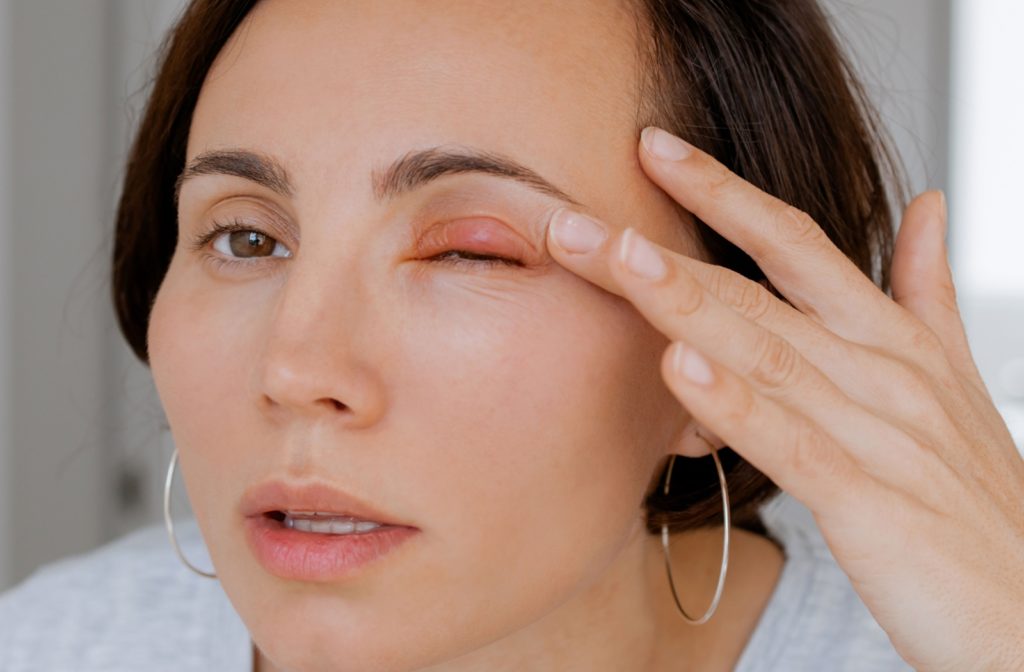If you’ve ever noticed a small, painful bump on your eyelid, there’s a decent chance you’re dealing with a stye. Styes are common and often appear as red, swollen lumps near the edge of the eyelid. They can be stressful to deal with—and seem to show up more frequently during these high-stress periods. This leads some people to claim stress actually causes them.
There is no direct link indicating stress can cause styes, however, the side effects of stress may increase your risk of getting a stye. We can diagnose and treat styes, but that’s just the start. We can also offer tips on preventing them from popping up again and ruining your day!
Stress & Your Eye Health
First, let’s understand what stress is. Stress is your body’s response to any demand or challenge, like worrying about a big presentation. When you’re stressed, your body releases hormones like cortisol and adrenaline. These hormones trigger a “fight or flight” response, increasing your heart rate and blood pressure. While this response is helpful in short bursts, chronic stress can take a toll on your body and mind.
The “body” part is important to remember. Some people focus purely on the psychological toll of stress, thinking about how it makes you irritated, worry, and have trouble concentrating. But stress can affect you physically. Our body is an interconnected machine, so you could even feel stress in your eyes.
What Are Styes?
Styes, or a hordeolum, share many similarities with acne. Just like acne, a stye can develop when glands in the skin become inflamed. In the case of a stye, one of the small oil glands or hair follicles along your eyelid has become infected. This could be due to dead cells, bacteria, or other debris.
There are 2 types of styes:
- External Stye: External styes are more common and, as the name suggests, exist on the outside of the eyelid. They can appear on either the top or bottom of the eyelid, typically due to an infection in an eyelash follicle.
- Internal Stye: Internal styes, on the other hand, occur when an oil gland inside the eyelid gets infected. This can lead to a painful bump facing your eyeball, making it quite uncomfortable.
Most styes are caused by Staphylococcus, a type of bacteria that normally resides harmlessly on your skin. However, when these bacteria transfer to your eye and become trapped in a gland or hair follicle, they can lead to an infection.
Other factors that can increase your risk of developing a stye include:
- History of styes
- Skin conditions like blepharitis, rosacea, or dandruff
- Eye allergies
- Leaving makeup on overnight
- Diabetes
- Rubbing your eyes
- Fair skin and light coloured eyes
What Are Stye Symptoms?
A red bump on the eyelid is a classic sign of a stye, but it’s not the only one. Other common stye symptoms include:
- Eyelid crust
- Redness
- Partial or total eyelid swelling
- Light sensitivity
- Eye soreness
- Watery eyes
- Feeling like something is stuck in your eye
- Blurred vision
The Link Between Stress & Styes
Now, let’s get to the heart of the matter. Can stress actually cause styes? While there isn’t direct evidence linking stress to styes, there is research that suggests stress can weaken the immune system. A weakened immune system can make you more susceptible to infections, including those that cause styes.
When you’re stressed, you may also have trouble sleeping, which can further lower your immunity as your body produces fewer white blood cells, which are essential for fighting off infections. A decrease in these cells can make it easier for bacteria to invade the glands in your eyelids, leading to the formation of a stye.
Additionally, stress and tiredness often lead to poor hygiene habits. You may go to bed without taking your makeup off properly and you may rub your eyes more frequently—often without washing your hands first—which can also contribute to stye development.

How to Treat a Stye
Most of the time, a stye will go away on its own in about a week. Styes also aren’t considered contagious. Though you could spread the bacteria, you can avoid this by washing your hands, cleaning pillowcases, and not trying to pop one.
In the meantime, a warm compress can help reduce pain and swelling while speeding up the stye’s natural drainage. Eye masks, such as a Bruder masks, are available to apply constant heat to your eyelids. The constant heat brings blood flow to the eyelids, allowing for all the important cells to come to help heal the stye. The heat also prevents the blocked oil from hardening, allowing expression of the oil. Soaking a washcloth in warm water, wringing out the excess water, is also useful. Performing these warm compresses several times daily for 10 to 15 minutes each time is the main treatment to practice.
However, some styes can be quite stubborn. If your stye persists beyond 2 weeks or worsens, it’s time to consult your eye doctor.
Of course, it would be better to stop the stye from appearing in the first place. Preventing styes involves good hygiene, such as:
- Regularly washing your hands with soap and water to prevent the transfer of bacteria to your eyes
- Avoiding touching your face or rubbing your eyes
- Using a gentle cleanser to clean your eyelid margins, especially if you’re prone to styes.
Since stress can increase your risk of styes, it’s also worthwhile to manage it if you can. Some ways to cope with stress include:
- Physical activity
- Relaxation techniques like yoga, meditation, and deep breathing exercises can help calm your mind.
- Getting 7–9 hours of sleep each night
- Talking about your stressors with a friend or a mental health professional
We Can Help Take Stye Stress Off Your Mind
while stress may not directly cause styes, it can weaken your immune system and contribute to the factors that lead to stye formation. If you’re frequently dealing with styes or other eye issues, don’t hesitate to book an appointment at Discover Eyecare for professional advice and treatment options.



